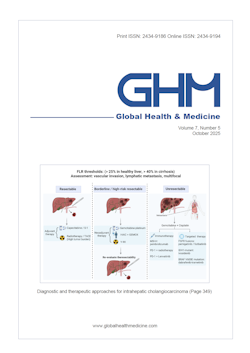Global Health & Medicine 2025;7(3):226-232.
Regional assessment is useful for identifying populations at high-risk of hepatitis B virus transmission: A nationwide analysis of population-based surveillance including the COVID-19 pandemic era
Okushin K, Aizaki H, Ikeuchi K, Kishida T, Kado A, Fujishiro M, Tsutsumi T, Takura T, Yotsuyanagi H
Prevention of new infections is important for the elimination of viral hepatitis B. Assessing the impact of the Coronavirus disease 2019 (COVID-19) pandemic on hepatitis B incidence is important for future infection control measures. A recent hospital-based questionnaire survey implied that a regional assessment in each country would be useful for establishing new preventive measures. This retrospective study examined publicly reported national data of patients diagnosed with acute hepatitis B in Japan between 2015 and 2022. The transition of total numbers, incidence, sex, and age distribution in each year were analyzed. Comparisons were made between populous and non-populous prefectures before and during the COVID-19 pandemic (2015–2019 vs. 2020–2022). A median of 210.0 patients with acute hepatitis B (interquartile range [IQR], 176.5–231.2 patients) were reported in each year. The number and incidence of acute hepatitis B cases significantly decreased during the pandemic, and the impact of COVID-19 was pronounced in males, especially in non-populous prefectures. Populous prefectures had significantly higher incidence in males compared with non-populous prefectures (3.55 [3.26–4.07] vs. 2.30 [1.78–2.64] cases per 1,000,000 people per year; p = 0.004), whereas those of females did not. Regarding patient age, the proportions of patients aged in their 20s, especially females, were higher in populous prefectures. These results may reflect differences in lifestyle, including sexual behaviors, in each population with the interaction of the COVID-19 pandemic. Identifying high-risk populations in each area and establishing a tailored strategy to eliminate viral hepatitis would be useful for countries worldwide.
DOI: 10.35772/ghm.2025.01010







